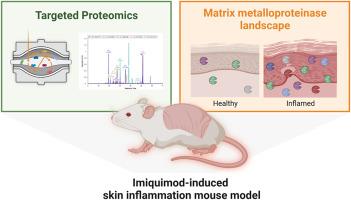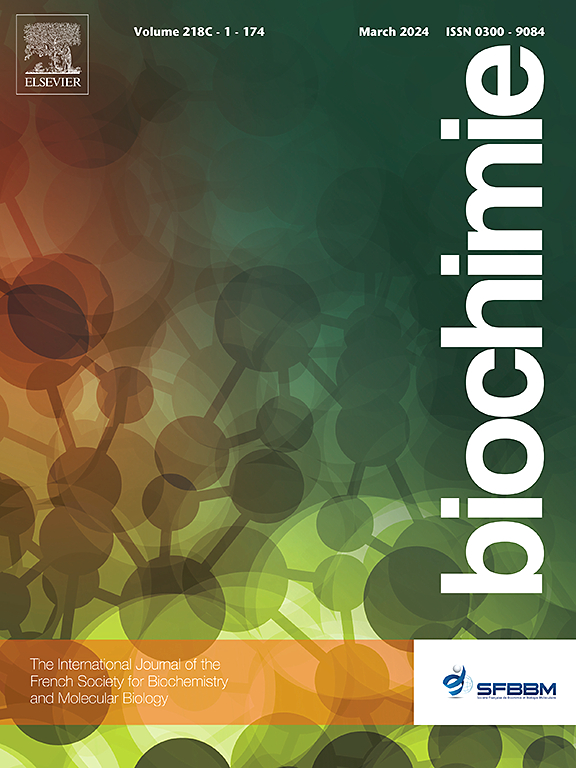Matrix metalloproteinase landscape in the imiquimod-induced skin inflammation mouse model
IF 3.3
3区 生物学
Q2 BIOCHEMISTRY & MOLECULAR BIOLOGY
引用次数: 0
Abstract
Inflammation and autoimmunity are known as central processes in many skin diseases, including psoriasis. It is therefore important to develop pre-clinical models that describe disease-related aspects to enable testing of pharmaceutical drug candidates and formulations. A widely accepted pre-clinical model of psoriasis is the imiquimod (IMQ)-induced skin inflammation mouse model, where topically applied IMQ provokes local skin inflammation. In this study, we investigated the abundance of a subset of matrix metalloproteinases (MMPs) in skin from mice with IMQ-induced skin inflammation and skin from naïve mice using targeted proteomics. Our findings reveal a significant increase in the abundance of MMP-2, MMP-7, MMP-8, and MMP-13 after treatment with IMQ compared to the control skin, while MMP-3, MMP-9, and MMP-10 were exclusively detected in the IMQ-treated skin. The increased abundance and broader representation of MMPs in the IMQ-treated skin provide valuable insight into the pathophysiology of skin inflammation in the IMQ model, adding to previous studies on cytokine levels using conventional immunochemical methods. Specifically, the changes in the MMP profiles observed in the IMQ-treated skin resemble the MMP patterns found in skin lesions of individuals with psoriasis. Ultimately, the differences in MMP abundance under IMQ-induced inflammation as compared to non-inflamed control skin can be exploited as a model to investigate drug efficacy or performance of drug delivery systems.


咪喹莫特诱导的皮肤炎症小鼠模型中基质金属蛋白酶的分布。
众所周知,炎症和自身免疫是包括银屑病在内的许多皮肤病的核心过程。因此,必须开发能描述疾病相关方面的临床前模型,以便对候选药物和制剂进行测试。一种广为接受的银屑病临床前模型是咪喹莫特(IMQ)诱导的皮肤炎症小鼠模型。在这项研究中,我们利用靶向蛋白质组学研究了IMQ诱导的皮肤炎症小鼠和幼稚小鼠皮肤中基质金属蛋白酶(MMPs)子集的丰度。我们的研究结果表明,与对照组皮肤相比,经 IMQ 处理后,MMP-2、MMP-7、MMP-8 和 MMP-13 的丰度明显增加,而在 IMQ 处理过的皮肤中只检测到 MMP-3、MMP-9 和 MMP-10。在 IMQ 处理过的皮肤中,MMPs 的丰度增加且具有更广泛的代表性,这为了解 IMQ 模型中皮肤炎症的病理生理学提供了宝贵的信息,补充了之前使用传统免疫化学方法对细胞因子水平进行的研究。具体来说,在经 IMQ 处理的皮肤中观察到的 MMP 图谱变化与银屑病患者皮损中发现的 MMP 模式相似。最终,在 IMQ 诱导的炎症中,MMP 丰度与非炎症对照皮肤的差异可被用作研究药物疗效或给药系统性能的模型。
本文章由计算机程序翻译,如有差异,请以英文原文为准。
求助全文
约1分钟内获得全文
求助全文
来源期刊

Biochimie
生物-生化与分子生物学
CiteScore
7.20
自引率
2.60%
发文量
219
审稿时长
40 days
期刊介绍:
Biochimie publishes original research articles, short communications, review articles, graphical reviews, mini-reviews, and hypotheses in the broad areas of biology, including biochemistry, enzymology, molecular and cell biology, metabolic regulation, genetics, immunology, microbiology, structural biology, genomics, proteomics, and molecular mechanisms of disease. Biochimie publishes exclusively in English.
Articles are subject to peer review, and must satisfy the requirements of originality, high scientific integrity and general interest to a broad range of readers. Submissions that are judged to be of sound scientific and technical quality but do not fully satisfy the requirements for publication in Biochimie may benefit from a transfer service to a more suitable journal within the same subject area.
 求助内容:
求助内容: 应助结果提醒方式:
应助结果提醒方式:


